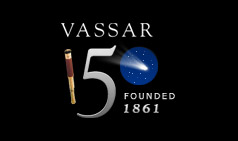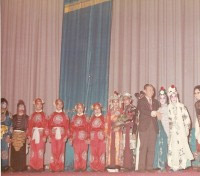The History of Chinese and Japanese at Vassar College
by Wenwei Du, Associate Professor of Chinese and Japanese
January 2011
Department Website
Although the department was established in the spring of 2004, Vassar began to offer courses of Chinese 43 years ago and of Japanese 38 years ago. The first session of the Chinese language class met on September 14, 1967 with 20 students (8 freshmen, 7 sophomores, 3 juniors, and 2 seniors), which successfully continued for the whole academic year. By the end of the following two years, the Chinese program had developed courses on three levels (elementary, intermediate, and advanced) and the Independent Work needed for students in their fourth year. The same pattern continued until 2002 when fourth-year Chinese was established as a regular course. Japanese language was first offered on campus in 1972 in the Critical Language Program whose name was later changed to the Self-Instructional Language Program. It continued in that fashion until 1984. Beginning in 1984, Japanese courses at three levels were instituted in Vassar’s curriculum with 10 students in first year Japanese, 8 in second year, and 5 in third year. The fourth year Japanese was added in 1994.
In terms of institutional structures, Chinese was under the Chinese Program until 1994 when the East Asian Studies (established in 1965) expanded into the Asian Studies Program. Japanese was first under the Critical Language Program (the former entity of the Self-Instructional Language Program) and later with formal courses under the East Asian Studies Program in 1985-1994. From 1994 to 2004, Chinese and Japanese language and literature/culture courses and their instructors were part in the Asian Studies Program. Correlate sequences in Chinese and Japanese languages were offered in the East Asian Studies and Asian Studies Programs. From the early 1990′s on, due to the increasing awareness of the importance of Asia in global politics and economy, the interest in Asia in various disciplines was growing rapidly. With various grants and endowments, the college hired scholars in Asian anthropology, art, education, economics, film, geography, history, literature, philosophy, political science, and religion. Based in their respective home departments, these faculty members contributed greatly to the rapid growth of the Asian Studies Program.
Under this new situation, with the increased number of the faculty members in East Asian languages and literature, the college established an independent department of Chinese & Japanese in the spring of 2004. The new department with the official name of the Department of Chinese and Japanese established, for the first time in Vassar history, the majors in Chinese and Japanese. The first group of majors were declared in the spring of 2004 and graduated in May 2005. The establishment of the department has been instrumental to the growth and development of the academic disciplines in East Asian languages, the scholarship of individual faculty members, and the development of the language/literature pedagogy. Since then, the department has been providing a new venue for Vassar students to pursue their studies of China and Japan while at the same time continuing to enrich the Asian Studies courses on campus.
The department’s approaches to its fields of study can be grouped into three categories. The first is language instruction. Here, we emphasize communicative skills in speaking and writing, the accumulative knowledge of non-Western culture through language learning, the acquisition of the analytical ability through grammar learning, and the creative use of the acquired linguistic skills in real-life situations. The second category encompasses literature and culture, in which we work to give students a broad understanding of literary genres from antiquity to the present, to give them opportunities to do comparative studies between Western and East-Asian cultures and between those of China and Japan, and to engage them in theoretical/methodological inquiry into Chinese and Japanese literature, culture, aesthetics, and philosophy. The third category is cultural and linguistic immersion, which students may experience through Vassar’s own summer programs (Vassar’s China Summer Program at Qingdao University, 2004-2009 and its Japan Summer Program at Ochanomizu University in Tokyo, 2006-2009), Vassar’s exchange programs with Ochanomizu University in Tokyo and Ritsumeikan University in Kyoto since 2006, an outside intensive summer program or Junior Year Abroad (Taiwan since 1969 and China since 1979). For the details of the department’s curriculum, see the college’s Catalogue.
Through the joint effort of the department faculty the enrollment of students in Chinese and Japanese language and culture courses has increased steadily and significantly. The average proficiency level of the students has been raised as more students are committing themselves to a study of three or four years of the language. Additionally, Vassar’s own China and Japan summer programs helped our students speak better and made it possible for a group of students to find time during normal semesters to take higher level courses.
In all of these areas, we ask a variety of questions including, how different or similar are the thinking patterns of English-speakers and Chinese/Japanese people as reflected by the word order and grammar of both languages? What are the effective methods in achieving high proficiency in a target language? How can the study of a new subject relating to China or Japan help one to develop critical and analytical ability? All of our courses serve the College’s goal of offering students a “thorough, well-proportioned, and liberal education.”
Since the very early times, the Chinese and Japanese faculty members have been organizing increasingly rich activities on Chinese and Japanese culture which included but are not limited to, Chinese New Year and Japanese Cherry Blossom Festivals, language tables, Chinese Corridor, lectures, film series, theatrical performances, trips to Chinatown, flower arrangement, tea ceremonies, Student Calligraphy Exhibitions, photo exhibits, and Culture Day.
In connection with our significant “first time”, there have been three “Grand Ladies”, Professor Yin-lien Chin, who was the founder of the Chinese Program on campus in 1967, the late Professor Ellinor Jordan, of Cornell University, “who’d descend de temps en temps”, serving as the Examiner of the early Japanese language studies at Vassar in the self-instructional format in 1972-1984, and Professor Tomiko West, who was the creator of regular Japanese courses on campus in 1984. Professor Walter Fairservis, who pushed tirelessly for the establishment of a formal Japanese language program, Professor Gillin, who was the longest serving director of East Asian Studies. The development of Chinese and Japanese studies has also been closely connected with change in world events. One anecdote went as follows:
“The United States and China established formal relations in 1979,” the Emerita Professor Yin-lien Chin recalls. “The Chinese government sent the first group of scholars…to visit USA. The co-leader of the group was Mr. Qi Li, who was the Vice Minister of Education. One Thursday afternoon I got a phone call from Mr. Cai [of the Chinese Consulate General in New York, who was my friend's friend]. He told me that the Vice Minister of Education, Mr. Li, was in NYC. He needed to talk to me next morning and I would be able to ask him directly about sending Vassar students to Beijing. I went to NYC on Friday morning…. Mr. Li asked me about college tuitions because the Chinese government was planning to send 500 graduate students to US. …An American business organization had promised to handle the placement of these graduate students at various colleges and universities. They would charge the Chinese government $10,000 per student. He had to sign a contract with them that afternoon. He asked me, ‘Was that a reasonable price?’ I showed him the Vassar Catalogue (Vassar’s tuition was $8,000 per year in 1979; NY state college’s was about $4,000) and told him that I didn’t think that the organization would be able to send Chinese graduate students to the Ivy League schools but would probably arrange for the students to study at state colleges somewhere in the mid-West. The tuition there is even cheaper than a NY state college. So I suggested that they pay $5000 per student for the tuition and their work. Mr. Li was very happy and grateful, and asked me how many students I wanted to send to Beijing. I told him I wanted to send 3 to 5 students each year and he said, “No problem.” And that is how Vassar became the first school to send 5 undergraduate students to Beijing, with the group of 65 graduate students and assistant professors sponsored by the US government in September 1979. The news was in the NY Times (2/5/79), and Vassar was quite happy about that.”
In the past years the physical places that housed the Chinese and Japanese faculty members included the Old Observatory for the Chinese Program until 1995 and Avery Hall where the Chinese & Japanese faculty members shared offices and classrooms with the Drama and Film department. In 2003, when Avery Hall was being renovated, the Chinese and Japanese faculty members moved to the attic of the Sanders Class Room Building which was remodeled into an office space with eight small rooms with or without a view. Plans had been discussed for a new building to replace the current Chicago Hall and to house all the foreign language/literature faculty.

